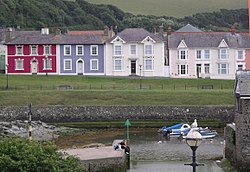Aberaeron
| Aberaeron | |
| Cardiganshire | |
|---|---|
 Houses on the quay | |
| Location | |
| Grid reference: | SN458628 |
| Location: | 52°14’31"N, 4°15’33"W |
| Data | |
| Population: | 1,520 |
| Post town: | Aberaeron |
| Postcode: | SA46 |
| Dialling code: | 01545 |
| Local Government | |
| Council: | Ceredigion |
| Parliamentary constituency: |
Ceredigion |
Aberaeron is a seaside resort town in Cardiganshire, on Cardigan Bay between Aberystwyth and Cardigan. It is at the mouth of the River Aeron, which enters the sea here in a broad stream which forms the town’s harbour.
The town’s name means "Mouth of the Aeron". It is not an ancient place in its current form but was planned and developed from 1805 by the Rev Alban Thomas Jones Gwynne, as a port and shipbuilding town, in which industries it remained throughout the nineteenth century.
Today’s town is in appearance more of a pretty holiday place, with a beach and guesthouses around the quay and the streets, and in season it famous honey icecream served at the Hive on the Quay.
History and design
The present town was planned and developed from 1805 by the Rev Alban Thomas Jones Gwynne. The harbour he built operated as a port and supported a shipbuilding industry in the 19th century. A group of workmen's houses and a school were built on the harbour's north side, but these were reclaimed by the sea.[1] Steam ships continued to visit the harbour until the 1920s but, in later years, it evolved into a small half-tide harbour for recreational craft. The estuary is also crossed by a wooden pedestrian bridge.
Crafts were an important part of village life. Information recorded in trade directories shows that in 1830, although it was not yet fully developed as a port, there were in Aberaeron one woollen manufacturer, one bootmaker, one baker, one corn miller, one blacksmith, one blacksmith and shovel maker, two shipwrights, one carpenter and one hat maker.[2]
In the late 1890s, a hand-powered cable car 'The Aeron Express' was built to ferry workers across the harbour when the bridge was demolished by floods. The structure was recreated in the late 1980s as a tourist attraction that ran until the end of summer 1994.
The architecture of Aberaeron is unusual in this part of the land in being constructed around a principal square of elegant Regency style buildings grouped around the harbour. This was the work of Edward Haycock, an architect from Shrewsbury. Some of the architecture was of sufficient interest to feature on British postage stamps.[1]
Castell Cadwgan
Castell Cadwgan, a 12th-century ringwork fortification around a probable wooden structure, was located by the shore at Aberaeron, but has long since been claimed by the sea. Few traces remain today apart from some mounds of earth, the remains of the enclosure bank, most of the site having been eroded.[3][4]
In Wales Illustrated in a Series of Views by Henry Gastineau, published in 1810, it states: "Near the town are some remains of an ancient fortress called Castell Cadwgan, thought to have been erected by king Cadwgan, about the year 1148." In A Topographical Dictionary of Wales, published in 1833, Samuel Lewis similarly wrote:
"On the sea-shore, near the village, is a circular encampment, designated Castell Cadwgan, and supposed to have been constructed by Cadwgan ab Bleddyn, about 1148." [5]
However, Cadwgan is recorded as having been killed in 1111.
About the town
Aberaeron is surrounded by open farmland on three sides and the sea on the fourth. Southward along the coast is the county towmn, Cardigan, and off to the north is Aberystwyth, the three joined by the A487. Here the A482 leads off southeast to Lampeter.
The shoreline consists of generally steep storm beaches of pebbles, although fine sand is visible at low tide levels. Aberaeron south beach was awarded the Blue Flag rural beach award in 2005.[6] It contains the Harbourmaster Hotel.
The town is well known for the sale of honey, honey ice-cream and, more recently, honey mustard.
70% of Aberaeron's inhabitants are able to speak Welsh according to the 2001 census.
A life-sized statue of a Welsh cob stallion was donated to the town in 2005 by the Aberaeron Festival of Welsh Ponies and Cobs to denote the area as Welsh Cob country. It was created by sculptor David Mayer.
Dylan Thomas's links with Aberaeron, New Quay and Talsarn have been documented by local author David N Thomas.[7] The Dylan Thomas Trail runs through Ceredigion, passing through Aberaeron and ending in New Quay[8]
An annual carnival takes place on the Monday Bank Holiday in August. A colourful procession of floats and a carnival queen moves from the Quay to Alban Square.[9][10]
Image gallery
-
The River Aeron
-
The Black Lion Hotel, on Alban Square
-
Harbour at low tide
-
Footbridge over the Aeron
-
Harbour and hills
-
Former workhouse
-
The Feathers (former coaching inn)
-
Welsh cob statue
-
Market Street
-
Georgian houses
-
Northgate Toll House, c. 1785
-
Prince's Avenue
References
- ↑ Jump up to: 1.0 1.1 Aberaeron 1807–2007: Aberaeron Town Trail, celebrating our heritage Heritage Treftadaeth, 2007 (under building 1 - General Storehouse)
- ↑ Jenkins, J. Geraint. Ceredigion: Interpreting an Ancient County. Gwasg Careg Gwalch (2005) pg. 83.
- ↑ Castell Cadwgan Aberaeron at 'Gatehouse' mediæval castles site
- ↑ BBC Website - Cymru Hanes - Aberaeron (in Welsh)
- ↑ Aberaeron West Wales tourism site
- ↑ Blue Flag website
- ↑ Dylan Thomas: A Farm, Two Mansions and a Bungalow, Seren 2000. Also see http://undermilkwood.webs.com
- ↑ The Dylan Thomas Trail, by D N Thomas, Y Lolfa, 2002
- ↑ Aberaeron Carnival at aberaeron.info website
- ↑ Aberaeron Carnival 2009 pictures at BBC West Wales
Outside links
| ("Wikimedia Commons" has material about Aberaeron) |











